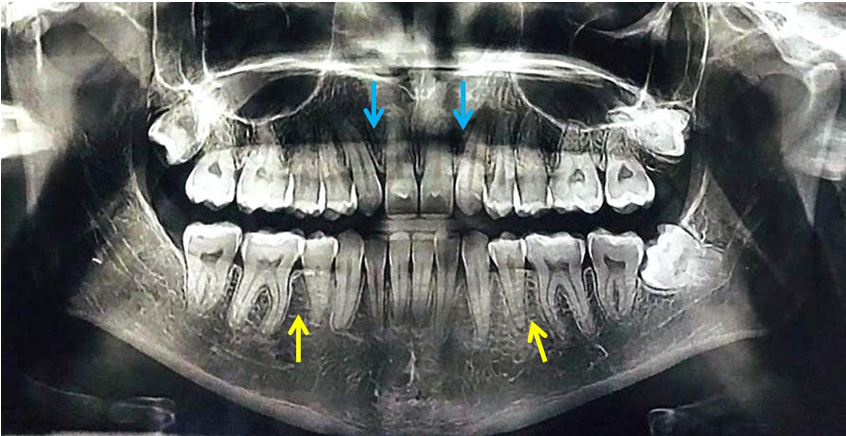Short Communication | DOI: https://doi.org/DSOMI-SC-24-007
Bilateral Non-syndromic Idiopathic Congenital Tooth Agenesis
Abstract
Idiopathic congenital dental agenesis is an uncommon clinical entity rarely found in a normal individual. This condition may involve either primary or permanent dentition, can occur in single or include multiple teeth. Diagnosis and management of tooth agenesis is very important to provide appropriate patient care. The present article briefly describes occurrence of bilateral idiopathic congenital tooth agenesis involving permanent maxillary lateral incisors and bilateral mandibular second premolars found in a 25-year-old Indian male patient.
Introduction
Literature search shows congenital agenesis of teeth occurring in a non-syndromic patient without any particular etiology which can be referred as an idiopathic nature. This clinical entity can involve any dentition either primary or permanent or any tooth [1]. The most commonly seen congenitally missing teeth are the third molars followed by maxillary lateral incisors and mandibular second premolars. There is no exact true etiology behind the occurrence of tooth agenesis; however, various genetic and environmental factors have been suggested as causative factors for tooth agenesis in humans [1]. The present article enlightens occurrence of bilateral idiopathic congenital dental agenesis involving maxillary lateral incisors and mandibular second premolars detected in an Indian patient following routine clinical and radiographic examination. Details of the present case are elaborated in Table 1 and Figure 1.


Discussion
Presence of tooth agenesis sometimes leads to spacing in the dental arch or can cause esthetic impairment. In the present case no spacing was observed as eruption of other teeth have accommodated well in the dental arch and filled the gap and also no esthetic impairment was observed. Nagaveni NB [2] recently correlated occurrence of permanent mandibular incisors agenesis in relation with the dermatoglyphic pattern among Indian population. In this research work, author found that the arch pattern was highly significant with the number greater for the study group compared to the control group. However, there was no statistically significant difference observed in the distribution of the dermatoglyphic patterns between females and males [2]. In the same Indian population, there is a case series showing occurrence of bilateral congenital agenesis of permanent mandibular central incisors as its prevalence is very low [3]. Tooth agenesis can also be found with other conditions belonging to different dental phenomenon thereby poking ‘quest’ for further research. There are some case reports depicting such interesting cases challenging to the dental science. A recent Indian case report showed concomitant existence of all four second premolar’s agenesis involving both maxillary and mandibular arches in association with presence of a supernumerary fourth molar [4]. The combination of tooth agenesis along with formation of an extra tooth or supernumerary tooth is an extremely rare clinical entity. Another publication illustrated occurrence of bilateral agenesis of maxillary second premolars in association with bilateral ectopic eruption of mandibular first molars in a patient from Indian ethnicity [5]. Mandibular third molars are the most commonly missing teeth. Sometimes these mandibular third molars become impacted within the alveolar bone and clinical examination leads to misdiagnosis of tooth agenesis [6-8]. Therefore, radiographic examination is highly essential to rule out presence of an unerupted teeth and their associated pathology. Detection of unusual dental anomalies or conditions is very important for documentation in the scientific literature. Documented and published uncommon dental variations help further research required in that particular domain. In addition to this, documented more scientific literature enable scientist and researchers to frame new guidelines, protocols related to investigational and therapeutic parameters so that ultimately there will be more benefit to the health research and to the patient [9,10].
References
-
Naji AZ, Tarek R. Mandibular second premolar agenesis: A retrospective cross-sectional study from Palestine. J Pharm Bioallied Sci, 2024; 16(suppl 1): S125-S129.
View at Publisher | View at Google Scholar -
Nagaveni NB. Comparative evaluation of dermatoglyphic pattern in children with or without congenital agenesis of permanent mandibular incisors. Pediatr Child Health Issu 2023; 4(1): DOI: http://doi/org/11.2023/1.1058.
View at Publisher | View at Google Scholar -
Nagaveni NB, Umashankara KV. Congenital bilateral agenesis of permanent mandibular incisors: Case reports and literature review. Arch Orofac Sci 2009; 4: 41-46.
View at Publisher | View at Google Scholar -
Nagaveni NB. Concomitant existence of tooth agenesis (agenesis of four second premolars) and supernumerary tooth (dens distomolar) – Report of a rarest case. J Dent Sci 2024; 9(1): 000391.
View at Publisher | View at Google Scholar -
Nagaveni NB. Bilateral agenesis of maxillary second premolars and bilateral ectopic eruption of mandibular first molars – A rare case report. Glob J Res Dent Sci 2023; 3(5): 16-20.
View at Publisher | View at Google Scholar -
Nagaveni NB. A rare combination of tooth agenesis in association with anomalous supernumerary tooth: Report of a rare case. Oral Health Dent 2023; 6(1): 18-21.
View at Publisher | View at Google Scholar -
Nagaveni NB, Umashankar KV. Localized idiopathic cemental hyperplasia involving all four third molars – Report of a rare case. J Dent Res Treat, 2024; 1(2): 1-7.
View at Publisher | View at Google Scholar -
Nagaveni NB, Umashankar KV, Chiranjeevi H, Ashwini KS. “Inversion” of impacted mandibular third molar in Ascending ramus of the mandible – Report of a rarest case. Clin Pathol, 2024; 8(1): 00185.
View at Publisher | View at Google Scholar -
Nagaveni NB. Labial triple talon cusp in a mesiodens – report of a new morphological variant with revised new classification system. Clin Pathol 2024; 8(1): 000187.
View at Publisher | View at Google Scholar -
Impaction of primary molars in Indian children – A retrospective radiographic study and upgraded new classification system. Clin Radiol Imag J 2024; 8(1): 000217.
View at Publisher | View at Google Scholar






